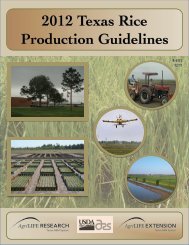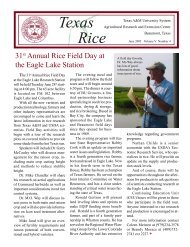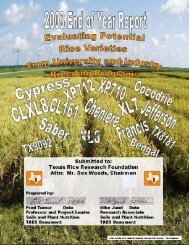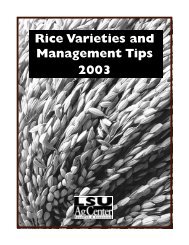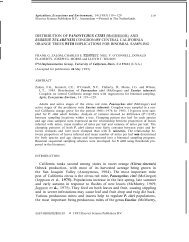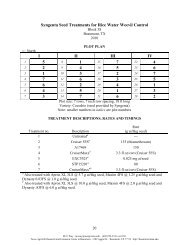2007 - Texas A&M AgriLIFE Research Center at Beaumont - Texas ...
2007 - Texas A&M AgriLIFE Research Center at Beaumont - Texas ...
2007 - Texas A&M AgriLIFE Research Center at Beaumont - Texas ...
Create successful ePaper yourself
Turn your PDF publications into a flip-book with our unique Google optimized e-Paper software.
Planting after the optimum planting d<strong>at</strong>es reduces the<br />
opportunity to produce high yields. It has been estim<strong>at</strong>ed<br />
th<strong>at</strong> a 5 percent reduction in first crop yield can be expected<br />
for each week’s delay in planting after April 21.<br />
Seeding R<strong>at</strong>es<br />
G. N. McCauley, L. Tarpley and M. F. Jund<br />
Uniform stands of healthy rice seedlings pave the way<br />
to a productive rice crop. Growers generally can achieve the<br />
desired plant popul<strong>at</strong>ion of 15 to 20 seedlings per square foot<br />
(9 to 12 seedlings per 7-inch drill row foot) by drill seeding<br />
70 to 90 pounds of rice seed per acre the first week of April.<br />
Lower seeding r<strong>at</strong>e and plant popul<strong>at</strong>ions (15 seedlings<br />
per square foot) are preferred when planting high tillering<br />
varieties, such as Cypress and Jasmine 85, and when disease<br />
pressure is expected to be high after canopy closure.<br />
These recommend<strong>at</strong>ions assume average seed size (Cocodrie,<br />
Cypress and Cheniere <strong>at</strong> 18,000 to 19,000 seed per<br />
pound), well prepared seedbeds, planting <strong>at</strong> recommended<br />
depths, good quality seed and near optimum conditions for<br />
April 1 planting.<br />
Adjusting seeding r<strong>at</strong>e for variety<br />
When planting a variety with seed th<strong>at</strong> is larger than<br />
average (Jefferson with 16,000 seed per pound) or smaller<br />
than average (Dixiebelle or hybrid seed with 20,000 to<br />
21,000 seed per pound), adjust the seeding r<strong>at</strong>e to ensure th<strong>at</strong><br />
you get the desired number of seed per square foot.<br />
For example, Jefferson ought to be planted <strong>at</strong> a 10<br />
percent higher r<strong>at</strong>e than th<strong>at</strong> used for Lemont and Gulfmont,<br />
15 percent over th<strong>at</strong> used for Cypress and Cocodrie and<br />
25 percent over th<strong>at</strong> used for Dixiebelle, assuming similar<br />
germin<strong>at</strong>ion and survival of each variety.<br />
This higher seeding r<strong>at</strong>e will help ensure th<strong>at</strong> varieties<br />
with lower-than-average numbers of seed per pound (such<br />
as Jefferson) will have a plant popul<strong>at</strong>ion similar to other<br />
varieties. Table 4 shows the effect of seed size on seed per<br />
square foot.<br />
Further increasing the seeding r<strong>at</strong>e of Jefferson can be<br />
justified because of its lower tillering and vigor. Compared to<br />
Cocodrie, Jefferson has lower tillering capacity. This makes<br />
it difficult for Jefferson to yield as well when stands are less<br />
than the recommended 20 to 25 seedlings per square foot.<br />
Table 4. Recommended seeding r<strong>at</strong>es adjusted for seed size and<br />
tillering for March 20 to April 1 planting on good seed beds.<br />
Variety<br />
Jefferson<br />
Lemont, Gulfmont<br />
Priscilla, Wells<br />
Cypress, Saber,<br />
Bolivar and Cocodrie<br />
Drill<br />
seeded<br />
90-100<br />
80<br />
70-80<br />
60-70<br />
Seeding r<strong>at</strong>e (lb/A)<br />
Broadcast<br />
(dry)<br />
110-120<br />
100<br />
100<br />
80-90<br />
W<strong>at</strong>er<br />
planted<br />
120-130<br />
120<br />
120<br />
110<br />
Low plant popul<strong>at</strong>ions of Jefferson (such as 12 live seedlings<br />
per square foot or about 40 pounds of seed per acre, assuming<br />
80 percent seedling emergence) will yield well if the<br />
seedlings are uniformly distributed and enough nitrogen is<br />
applied early.<br />
Adjusting seeding r<strong>at</strong>e for conditions<br />
Below are recommend<strong>at</strong>ions and consider<strong>at</strong>ions when<br />
adjusting seeding r<strong>at</strong>e according to planting conditions:<br />
• For broadcast seeding, use an additional 20 pounds of<br />
seed per acre above the 70 to 90 pounds per acre of<br />
drilled seed.<br />
• If the seedbeds are rough or poorly prepared, increase<br />
the seeding r<strong>at</strong>e by 10 pounds or more.<br />
• For each week the crop is seeded before March 15,<br />
you may need an additional 10 pounds of seed because<br />
earlier planting usually means cooler we<strong>at</strong>her.<br />
• You might not need to increase the seeding r<strong>at</strong>e if soil<br />
and air temper<strong>at</strong>ures are 70 degrees or above. However,<br />
growers who have had problems achieving recommended<br />
stands should use higher seeding r<strong>at</strong>es.<br />
• When drilling to moisture in stale seedbed conditions,<br />
you can generally reduce the seeding r<strong>at</strong>e by 10 to 15<br />
percent from conventional seedbed conditions.<br />
• If soil conditions require a germin<strong>at</strong>ion flush and Command<br />
will be applied preplant, increase the seeding r<strong>at</strong>e<br />
to 10 percent above conventional recommend<strong>at</strong>ions.<br />
• You can reduce the need for higher seeding r<strong>at</strong>es by<br />
using gibberellic acid as a seed tre<strong>at</strong>ment, which can<br />
increase seedling vigor.<br />
Replanting is not recommended unless stands have fewer<br />
than 8-10 seedlings per square foot over most of the field<br />
for semidwarf varieties and 5 seedlings per square foot for<br />
hybrids. If there are fewer than 15 seedlings per square foot,<br />
you can improve plot yields by increasing early nitrogen<br />
applic<strong>at</strong>ions by 30 to 50 pounds per acre.<br />
Rice producers who commonly achieve optimum planting<br />
density recognize th<strong>at</strong> actual seedlings per square foot (plant<br />
popul<strong>at</strong>ion) is a better measure for comparing field performance<br />
than seeding r<strong>at</strong>e because plant popul<strong>at</strong>ion is the final<br />
product of:<br />
• Seeding r<strong>at</strong>e<br />
• Live seed per pound of seed (determined by percent<br />
germin<strong>at</strong>ion and seed size)<br />
• Percent emergence (determined by planting conditions,<br />
such as seed depth and vigor, soil moisture, temper<strong>at</strong>ure,<br />
seedling disease and bird feeding)<br />
Measuring seedling stand density<br />
Growers are encouraged to count seedlings per square<br />
foot for a given seeding r<strong>at</strong>e. This inform<strong>at</strong>ion becomes<br />
very important in subsequent years when the seeding r<strong>at</strong>e<br />
is adjusted for variety and planting conditions. The best<br />
measurements of stand density can be made <strong>at</strong> the three- to<br />
four-leaf rice stage. After the fourth leaf, tillering makes<br />
stand counts very difficult.<br />
In broadcast rice, stand density can be measured using<br />
square or circular hoop of 1, 2, 3 or more square feet. The<br />
–––––––––––––––––––––––––––––––––––––––––––––––––––––––––––––––––––––––––––––––––––––



